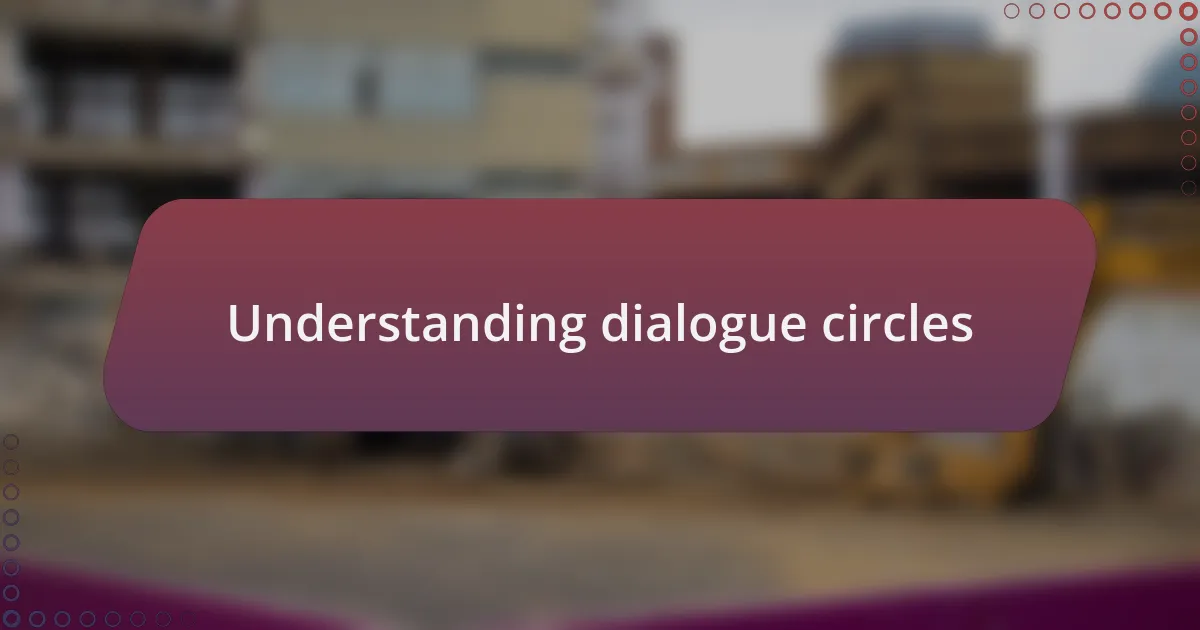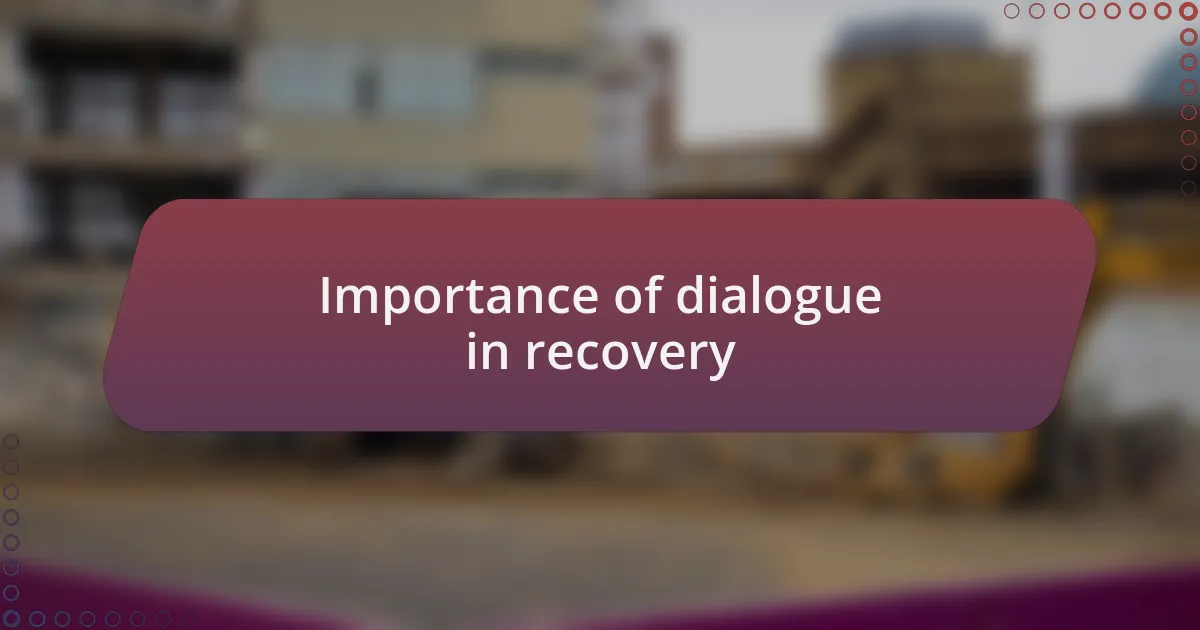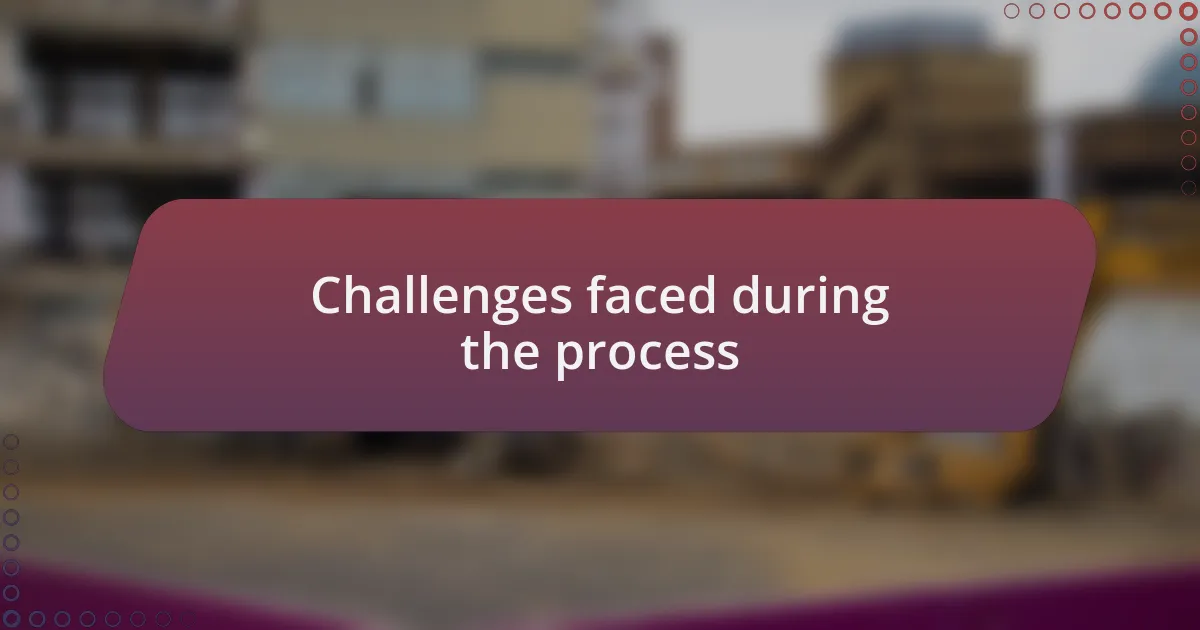Key takeaways:
- Dialogue circles create safe spaces for open communication, fostering understanding and vulnerability among participants.
- Active listening and storytelling are crucial for building connections and empowering individuals during the recovery process.
- Facilitating dialogue requires sensitivity to participants’ needs, addressing challenges like differing communication styles and time constraints.
- Outcomes of dialogue circles include transformed attitudes, deeper understanding, and actionable insights for community rebuilding.

Understanding dialogue circles
Dialogue circles create a space where voices can be heard and respected. I remember the first time I participated in one; it felt like stepping into a haven where everyone was encouraged to share their feelings and thoughts openly. Isn’t it incredible how such a simple arrangement can foster profound connections among people who have often felt unheard?
At their core, dialogue circles are rooted in the belief that everyone brings valuable perspectives to the table. When I facilitated a circle after a community conflict, I was struck by how different narratives emerged when individuals listened actively. Have you ever noticed how understanding another’s story can shift your entire viewpoint? It’s a powerful reminder of our shared humanity.
These gatherings often use a talking piece that’s passed around, giving each participant a turn to speak without interruption. I recall a time when a participant held the piece tightly, visibly shaking as they shared their painful experiences. In that moment, the circle transformed; it became a sanctuary for healing, showing us that vulnerability can lead to strength and solidarity.

Importance of dialogue in recovery
Engaging in dialogue during the recovery process plays a critical role in rebuilding trust and understanding within communities. I remember a session where community members discussed their fears and hopes regarding the aftermath of conflict. The moment a woman shared her fear of being judged for her past, you could feel the room shift; everyone leaned in, and it was as if we collectively decided to embrace vulnerability. Isn’t it remarkable how sharing our fears can create a bond that hardens into a foundation for healing?
Moreover, dialogue allows individuals to confront and dismantle the narratives that often perpetuate division. I once witnessed a participant challenge their own misconceptions when someone with a different background shared a personal story that mirrored their own struggles. This exchange sparked a realization that we all have more in common than we might initially believe. Have you ever had a moment where you suddenly connected dots between your story and someone else’s? That shared recognition can spark transformative change.
The therapeutic power of these dialogues cannot be overstated. By fostering an environment where individuals feel safe to express their emotions, dialogue circles facilitate not just healing but also empowerment. In one session, a participant carved out the courage to speak about their traumatic experiences for the first time. As I looked around, I saw not only empathy but the strength of community; it was a beautiful reminder that shared dialogue can plant the seeds for resilience and recovery.

Implementing dialogue circles effectively
Implementing dialogue circles effectively requires careful planning and a deep sensitivity to the needs of participants. In one instance, I was part of a group tasked with creating a safe space for conversations. We introduced ground rules, emphasizing respect and active listening. It was fascinating to see how those simple guidelines encouraged openness. Have you ever noticed how the right structure can shift the atmosphere entirely?
In my experience, the timing and pacing of each dialogue are crucial. During a particularly impactful session, I facilitated discussions by allowing participants to share their thoughts without interruptions. This created an ebb and flow that gave everyone room to breathe, reflect, and respond. When a participant later expressed gratitude for being allowed to finish their thoughts without feeling rushed, it hit home for me. Isn’t it incredible how slowing down can lead to richer conversations?
Additionally, incorporating storytelling into the circle often leads to deeper connection. I recall a moment when a participant recounted their experience of loss through a beloved family story. Watching faces light up with recognition and empathy around the circle was both moving and powerful. It reminded me that sometimes, sharing our narratives is a bridge to understanding others. Have you ever experienced the magical unfolding of connections through someone’s story? Those revelations can be the cornerstone of a healing journey.

Challenges faced during the process
Facilitating dialogue circles is rewarding, but it’s not without challenges. One significant hurdle I encountered was the reluctance of participants to engage openly. In one session, I noticed a few individuals holding back, and it struck me that the weight of their past experiences made vulnerability feel daunting. Have you ever seen someone struggle to speak up because of fear? In those moments, a gentle nudge and reassurance often helped, underscoring the importance of building trust.
Another challenge arose from differing communication styles. Some participants were more expressive, while others preferred to listen quietly. During one particularly tense dialogue, I witnessed a clash that left the air thick with discomfort. It was a stark reminder that not everyone processes feelings in the same way. This calls into question: How can we create a space that honors these differences while fostering connection? In my experience, finding common ground through shared goals can bridge those gaps.
Time constraints also posed obstacles in the process. I remember a session where, despite the rich discussion, we ran out of time without reaching the conclusions we aimed for. It’s frustrating, isn’t it, when meaningful dialogue gets cut short? This taught me the value of integrating time management into planning, ensuring that each voice is heard while still allowing room for necessary reflections. Balancing depth with timeliness is a delicate dance that can challenge even the most seasoned facilitators.

Outcomes of using dialogue circles
The outcomes of using dialogue circles can be profoundly transformative. In one memorable session, I witnessed a palpable shift in participants’ attitudes. A once-skeptical individual emerged as a leader, guiding the conversation with newfound confidence. It made me realize how powerful shared experiences can be in elevating voices that were previously stifled. Have you ever seen someone break through their own barriers? It’s awe-inspiring.
Another significant outcome was the emergence of deeper understanding among participants. I recall a moment when two individuals, who had once held opposing views, found common ground over a shared goal of peace within their community. This unexpected connection ignited a ripple effect, inspiring others to engage with one another in ways I hadn’t anticipated. It’s a reminder that dialogue circles can serve as a bridge, fostering empathy and collaboration. Why do we often underestimate the potential for reconciliation in conversation?
Moreover, I found that dialogue circles can lead to actionable insights for community rebuilding. One time, after discussing grievances and aspirations, a group collectively brainstormed a project to support local youth. Witnessing their transition from shared pain to proactive solutions was enlightening. How often do we actually channel dialogue into purposeful actions? For me, that moment underscored the practical impact that engaging conversations can have, illuminating pathways for lasting change.

Lessons learned from participation
Participating in dialogue circles taught me the importance of active listening. In one session, I sat quietly as a participant shared their story of loss, and I felt the weight of their pain. It struck me that sometimes, simply offering space for someone’s voice can be as powerful as any solution we might propose. Have you ever considered how much healing can stem from just being present for someone else?
One of the most profound lessons was recognizing the value of vulnerability. I remember when I chose to share my own hesitations about the process, which encouraged others to do the same. This mutual sharing opened new avenues of trust. Isn’t it amazing how showing our imperfections can lead to stronger connections and a more supportive environment?
Lastly, being part of these circles highlighted that change often begins with small steps. I witnessed participants transform their frustration into creativity—like proposing a community art project inspired by shared stories. It made me realize that sometimes, substantial recovery starts with a simple, collective idea. How often do we overlook the power of a single initiative to spark broader transformation?